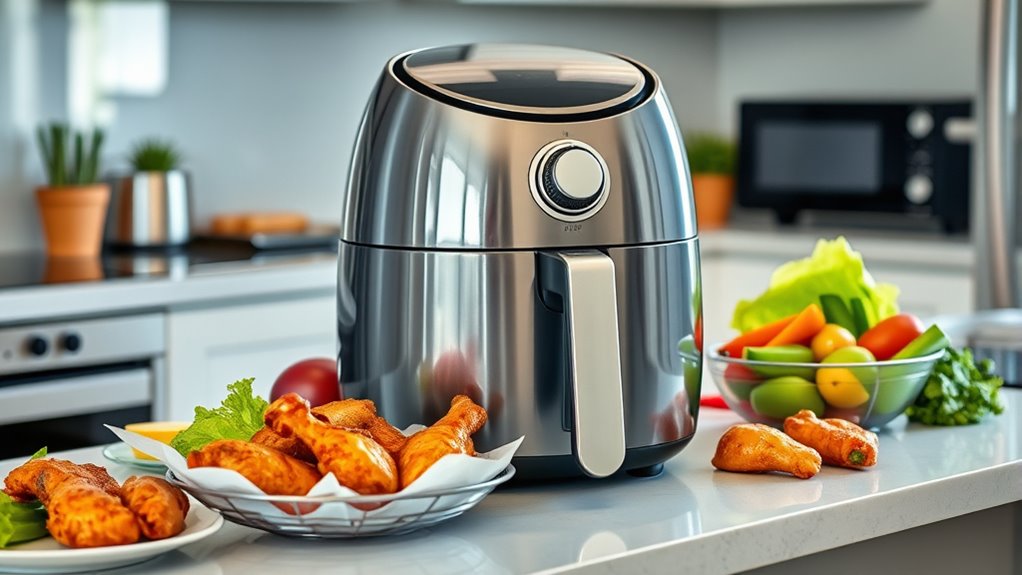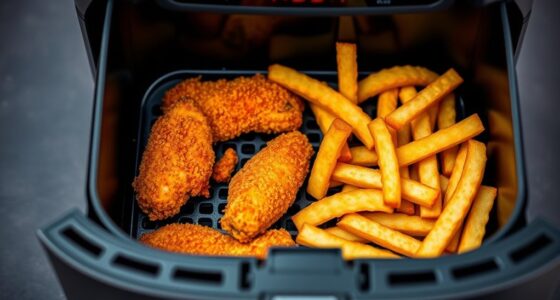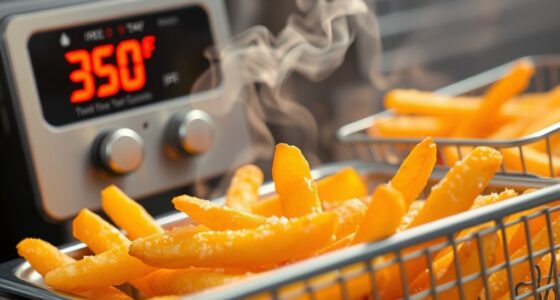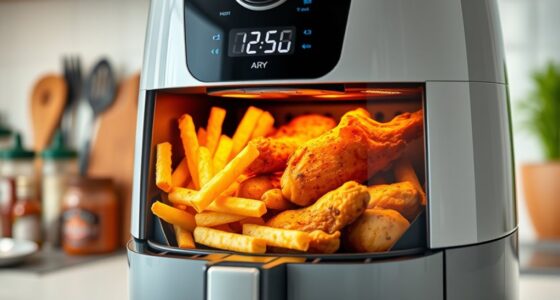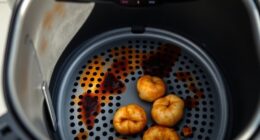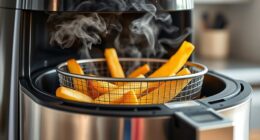When you’re new to air frying, avoid overcrowding the basket so hot air circulates evenly. Always preheat your device for 3-5 minutes to *guarantee* consistent results. Use just a light coating of oil on your food for crunch without grease. Remember to shake or flip your food halfway through cooking to prevent sogginess. And don’t rely solely on the recipe time—check for doneness to get perfect meals. Stick with these tips, and you’ll master your air fryer faster than you think.
Key Takeaways
- Don’t overcrowd the basket; leave space for hot air to circulate evenly.
- Always preheat your air fryer for 3-5 minutes to ensure consistent cooking.
- Lightly coat food with oil to prevent sticking and achieve crispiness.
- Remember to shake or flip food halfway through for even texture and flavor.
- Avoid relying solely on cooking time; check food visually or with a thermometer for perfect results.
Overcrowding the Basket
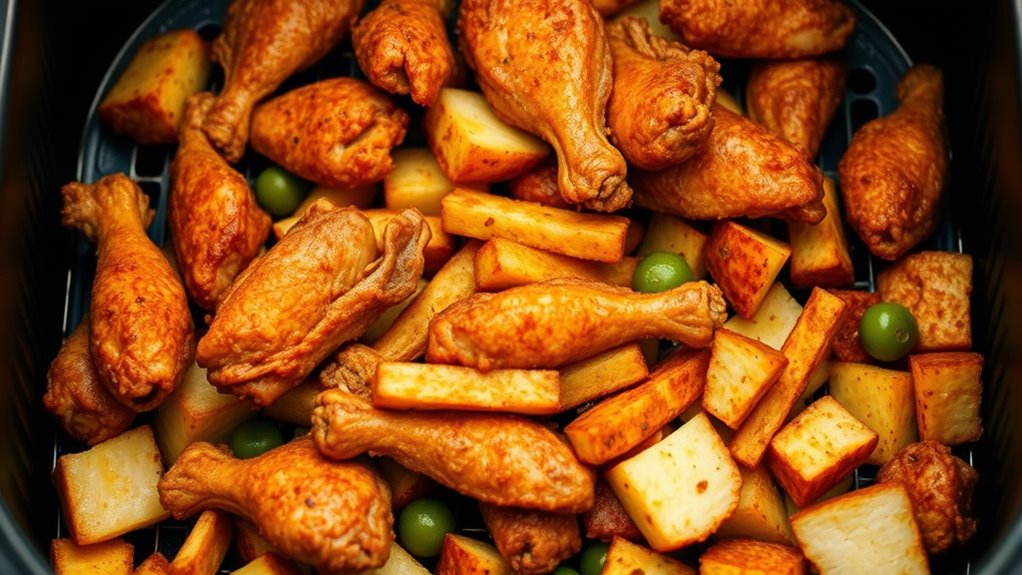
One common mistake beginners make is overcrowding the air fryer basket, which can prevent the food from cooking evenly. The key is to choose the right basket size for your meal and avoid stuffing it full. When food is packed too tightly, hot air can’t circulate properly, leading to uneven cooking or soggy results. Proper food placement is essential; spread items in a single layer without overlapping, so air can reach all sides. If your basket is too small for what you’re cooking, consider cooking in batches instead of trying to cram everything in at once. This ensures each piece cooks thoroughly and crisply. Remember, leaving space in the basket helps your air fryer perform at its best, producing better, more consistent results. Additionally, understanding air circulation principles can help optimize your cooking outcomes.
Ignoring Proper Preheating
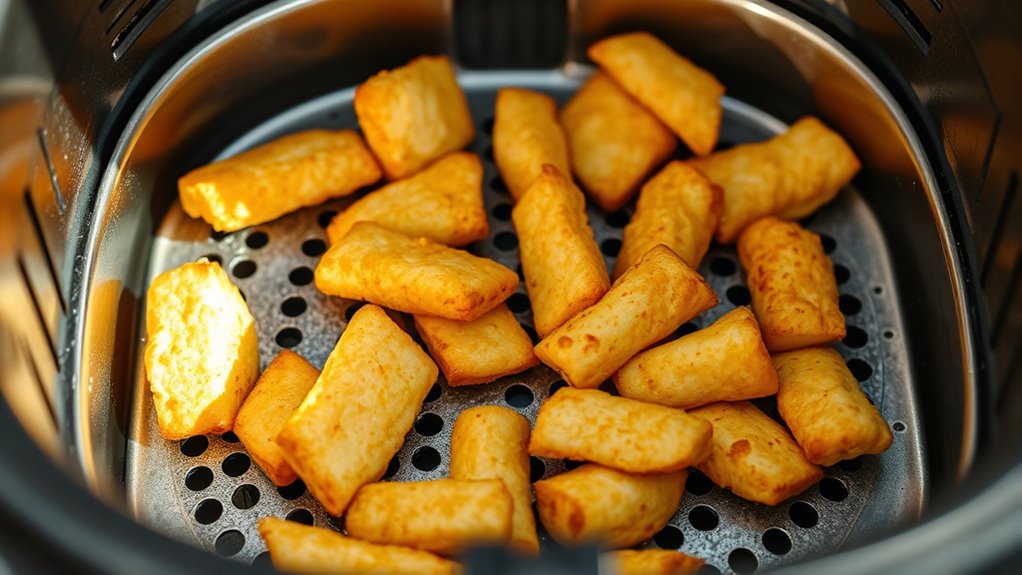
Ignoring proper preheating is a common mistake that can compromise your air fryer’s performance. Preheating essentials involve running your air fryer at the target temperature for a few minutes before adding food. This step ensures even cooking and crispiness. Skipping preheating can lead to uneven results and longer cook times. Additionally, proper temperature calibration is vital; if your air fryer runs hot or cool, preheating helps compensate for these discrepancies. Always check your device’s manual for recommended preheating times, typically 3-5 minutes. By not preheating, you risk undercooked or soggy food. Make preheating a habit to maximize efficiency, achieve consistent results, and keep your air fryer in top shape.
Not Using Enough Oil or Coating
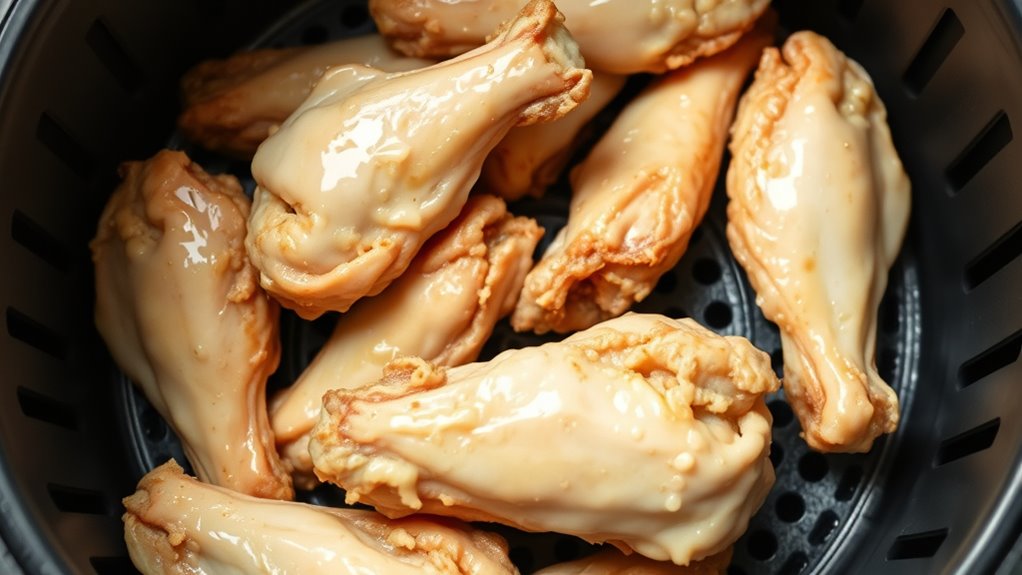
Failing to use enough oil or coating can lead to food sticking to the basket or turning out dry and lackluster. To get crispy, well-coated results, pay attention to the oil amount and coating thickness. Too little oil, and your food may stick or lack flavor; too much, and it becomes greasy. Aim for a light, even coating that enhances texture without overdoing it. Here’s a quick guide:
| Oil Amount | Coating Thickness | Result |
|---|---|---|
| Minimal | Very Thin | Sticks, dry, less crispy |
| Moderate | Even, light layer | Crispy, flavorful, well-coated |
| Excessive | Thick layer | Greasy, soggy, overdone |
Balance is key—use enough oil for a crispy finish but avoid heavy coatings. Additionally, proper coating technique can make a significant difference in achieving consistent, delicious results.
Forgetting to Shake or Flip Food

If you don’t shake or flip your food during air frying, you risk uneven cooking and a less desirable texture. Regularly tossing or flipping ensures proper seasoning distributes evenly and that food with different thicknesses cooks uniformly. Thicker pieces, like chicken breasts or potato wedges, need to be flipped halfway to avoid burning on one side and undercooking on the other. Skipping this step can result in dry, overcooked spots or soggy areas. Remember to check for food that’s uneven in size or density, and adjust your flipping schedule accordingly. Properly flipping or shaking your food not only promotes even cooking but also enhances flavor and texture. It’s a simple step that makes a big difference in your air frying results. Additionally, understanding the importance of even heat distribution can help you achieve consistently better outcomes with less guesswork.
Relying Solely on Cooking Time
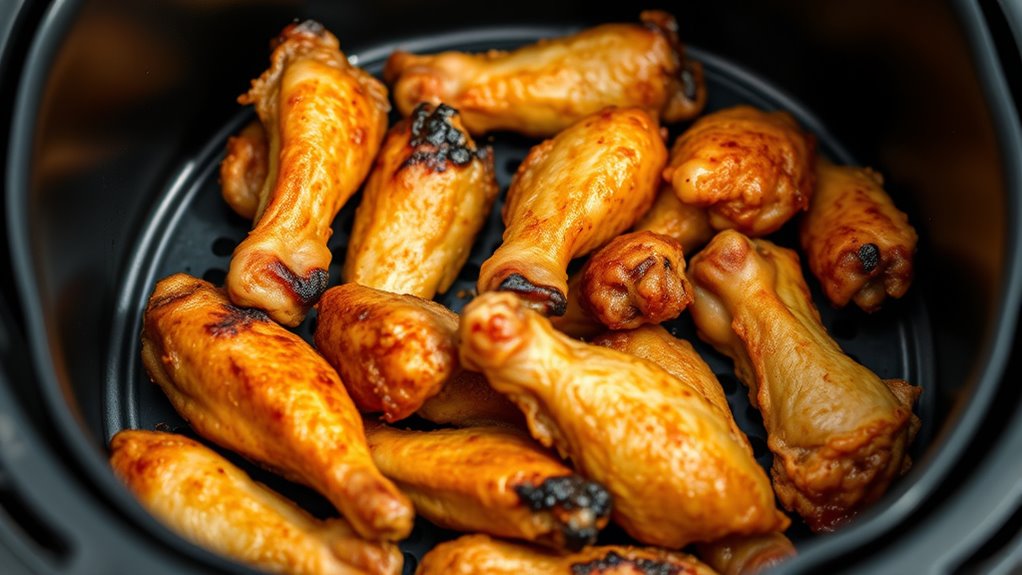
Relying solely on the recommended cooking time can lead to undercooked or overdone food, even if the timer runs out exactly as specified. Every air fryer varies slightly, so adjusting temperature settings is essential for perfect results. Instead of sticking rigidly to the time, check your food halfway through and use visual cues or a food thermometer to gauge doneness. Selecting the right cooking mode can also make a difference; some air fryers have specific settings for different foods, ensuring even cooking. Keep in mind that factors like thickness, moisture content, and starting temperature influence cook times. Being aware of air fryer variability helps you adapt and achieve consistent, delicious results without overcooking or undercooking your meals.
Frequently Asked Questions
How Do I Choose the Right Size Air Fryer for My Needs?
When choosing an air fryer, consider its capacity to match your typical meal size, ensuring you can cook enough for your household. Think about your kitchen space considerations—measure available counter space to find a model that fits comfortably without crowding. Larger capacities are great for families, while smaller ones suit singles or couples. Picking the right size helps you enjoy efficient cooking without sacrificing space or functionality.
Can I Cook Multiple Types of Food Together in One Batch?
Coincidentally, you can cook multiple types of food together, but it depends on food flavor compatibility and cooking time adjustments. Keep in mind, some foods release moisture or strong flavors that might affect others, so choose items wisely. To guarantee even cooking, consider stirring or shifting foods midway. Adjust cooking times accordingly, and avoid overcrowding the basket, so everything cooks properly without mixing flavors undesirably.
What Are Safe Cleaning Practices for My Air Fryer?
To keep your air fryer safe and in top shape, follow proper cleaning routines and safety precautions. Always unplug it before cleaning, and use a soft cloth or sponge with warm, soapy water to wipe down the basket and interior. Avoid abrasive tools that could damage surfaces. Regular cleaning prevents residue buildup, ensuring safe operation and better-tasting food. Remember to dry all parts thoroughly before reassembling and using again.
Are There Specific Foods I Should Avoid Air Frying?
Did you know that certain foods can cause smoking or damage your air fryer? You should avoid food incompatibilities like greasy bacon or wet batter, which can create messes or harm the appliance. Instead, consider ingredient substitutions such as using cornstarch instead of flour for crispy coatings. Stay mindful of these tips to make certain of safe, efficient cooking, and enjoy your air frying experience without unnecessary mishaps.
How Do I Adjust Recipes for Different Air Fryer Models?
When adjusting recipes for different air fryer models, you need to focus on recipe conversions and temperature adjustments. Start by reducing the cooking temperature by about 25°F if your model runs hotter, and check your food earlier than the suggested time. Keep an eye on the results and tweak as needed. This way, you guarantee your dishes cook perfectly, regardless of the air fryer you use.
Conclusion
Now that you know these common rookie mistakes, you’re better equipped to nail your air frying debut. Avoid overcrowding, preheat properly, and give your food a good shake or flip. Remember, cooking times are guides, not rules—trust your senses. So, are you ready to master your air fryer and enjoy perfectly crispy dishes every time? With a little practice, you’ll wonder how you ever cooked without it. Happy frying!
